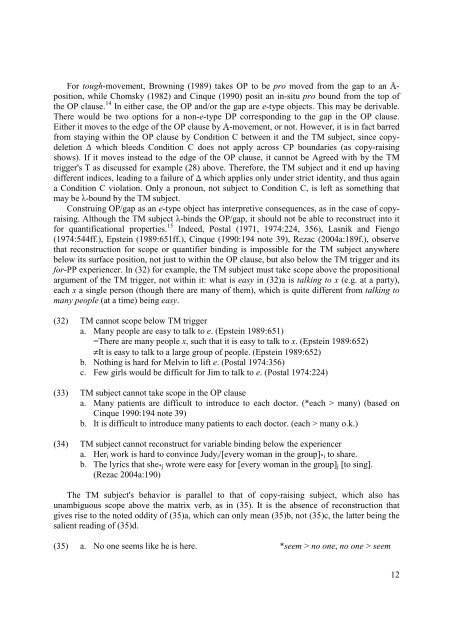1 On tough-movement* Milan Rezac, University ... - Multimania.co.uk
1 On tough-movement* Milan Rezac, University ... - Multimania.co.uk
1 On tough-movement* Milan Rezac, University ... - Multimania.co.uk
Create successful ePaper yourself
Turn your PDF publications into a flip-book with our unique Google optimized e-Paper software.
For <strong>tough</strong>-movement, Browning (1989) takes OP to be pro moved from the gap to an Ā-<br />
position, while Chomsky (1982) and Cinque (1990) posit an in-situ pro bound from the top of<br />
the OP clause. 14 In either case, the OP and/or the gap are e-type objects. This may be derivable.<br />
There would be two options for a non-e-type DP <strong>co</strong>rresponding to the gap in the OP clause.<br />
Either it moves to the edge of the OP clause by Ā-movement, or not. However, it is in fact barred<br />
from staying within the OP clause by Condition C between it and the TM subject, since <strong>co</strong>pydeletion<br />
which bleeds Condition C does not apply across CP boundaries (as <strong>co</strong>py-raising<br />
∆<br />
shows). If it moves instead to the edge of the OP clause, it cannot be Agreed with by the TM<br />
trigger's T as discussed for example (28) above. Therefore, the TM subject and it end up having<br />
different indices, leading to a failure ∆ of which applies only under strict identity, and thus again<br />
a Condition C violation. <strong>On</strong>ly a pronoun, not subject to Condition C, is left as something that<br />
may be λ-bound by the TM subject.<br />
Construing OP/gap as an e-type object has interpretive <strong>co</strong>nsequences, as in the case of <strong>co</strong>pyraising.<br />
Although the TM subject λ-binds the OP/gap, it should not be able to re<strong>co</strong>nstruct into it<br />
for quantificational properties. 15 Indeed, Postal (1971, 1974:224, 356), Lasnik and Fiengo<br />
(1974:544ff.), Epstein (1989:651ff.), Cinque (1990:194 note 39), <strong>Rezac</strong> (2004a:189f.), observe<br />
that re<strong>co</strong>nstruction for s<strong>co</strong>pe or quantifier binding is impossible for the TM subject anywhere<br />
below its surface position, not just to within the OP clause, but also below the TM trigger and its<br />
for-PP experiencer. In (32) for example, the TM subject must take s<strong>co</strong>pe above the propositional<br />
argument of the TM trigger, not within it: what is easy in (32)a is talking to x (e.g. at a party),<br />
each x a single person (though there are many of them), which is quite different from talking to<br />
many people (at a time) being easy.<br />
(32) TM cannot s<strong>co</strong>pe below TM trigger<br />
a. Many people are easy to talk to e. (Epstein 1989:651)<br />
=There are many people x, such that it is easy to talk to x. (Epstein 1989:652)<br />
≠It is easy to talk to a large group of people. (Epstein 1989:652)<br />
b. Nothing is hard for Melvin to lift e. (Postal 1974:356)<br />
c. Few girls would be difficult for Jim to talk to e. (Postal 1974:224)<br />
(33) TM subject cannot take s<strong>co</strong>pe in the OP clause<br />
a. Many patients are difficult to introduce to each doctor. (*each > many) (based on<br />
Cinque 1990:194 note 39)<br />
b. It is difficult to introduce many patients to each doctor. (each > many o.k.)<br />
(34) TM subject cannot re<strong>co</strong>nstruct for variable binding below the experiencer<br />
a. Her i work is hard to <strong>co</strong>nvince Judy i /[every woman in the group] *i to share.<br />
b. The lyrics that she *j wrote were easy for [every woman in the group] j [to sing].<br />
(<strong>Rezac</strong> 2004a:190)<br />
The TM subject's behavior is parallel to that of <strong>co</strong>py-raising subject, which also has<br />
unambiguous s<strong>co</strong>pe above the matrix verb, as in (35). It is the absence of re<strong>co</strong>nstruction that<br />
gives rise to the noted oddity of (35)a, which can only mean (35)b, not (35)c, the latter being the<br />
salient reading of (35)d.<br />
(35) a. No one seems like he is here. *seem > no one, no one > seem<br />
12
















